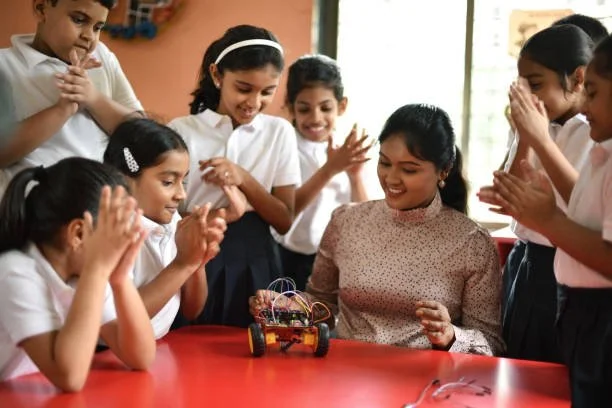Discovering STEM: A Kid's First Look into the Exciting World of Science
Have you ever wondered what makes that lamp turn on? Why do rainbows appear after the rain? Or how a tiny seed grows into a towering tree?
These are just a peek into the wondrous world of STEM – Science, Technology, Engineering, and Math.
But wait, you might also think, aren't these subjects only for grown-ups in lab coats and classrooms?
Absolutely not! The journey into STEM begins much earlier, right from the moment a curious child asks their first "why?"
What STEM Stands For?
First of all, let’s have a look at what STEM stands for.
STEM stands for Science, Technology, Engineering, and Math, which are like the superheroes of the learning world. Science helps us explore, Technology brings gadgets to life, Engineering is all about building things, and Math is the secret code behind it all. It's a mix of everything that makes our world tick!
Is It Only For Adults? No Way!
STEM isn't just about tough stuff like equations; it's about exploring, asking questions, and solving problems in a creative way.
And guess what?
Kids are naturally good at it with their curious minds.
When we introduce them early, it's like sparking a love for learning, boosting critical thinking, and unlocking awesome opportunities for them.
When We Should Start Introducing
The answer is “Earlier, Better”!
The foundations of STEM can be laid as early as preschool. By introducing basic concepts through play and interactive activities, children can develop a solid understanding of STEM principles.
Building block towers teach them about balance and structure, playing with water exploring buoyancy and flow, and even simple counting games introduce them to the world of numbers.
K-12 Dive states that:
“Children who get excited about science earlier and see the subject just as a fun way to explore the world around them will be more likely to push themselves in school.”
Let’s see why they have become more capable of doing so.
According to the investigation report of the responses Children in STEM, they experimented with research on 1st graders for one year and the results came into 3 themes.
Value of Collaboration
Application of Critical Thinking
Positive Dispositional Characteristics
Early STEM education helps children blossom into well-rounded individuals equipped to excel in academics, social settings, and beyond.
It's not just about building robots; it's about building strong, confident, and inquisitive minds prepared to tackle the future with enthusiasm and creativity.
What are the channels for them to get introduced?
1. In the classroom
STEM-focused schools: Many schools are now incorporating STEM principles into their curriculum, offering specialized classes in subjects like robotics, coding, and engineering.
Field trips: Field trips to museums, science centers, and other educational institutions can provide a hands-on experience with STEM concepts.
2. At Home
Science experiments: There are countless science experiments that you can do at home with simple materials. These experiments can help children learn about different scientific concepts in a fun and engaging way.
Coding games and apps: There are many coding games and apps available that can teach children the basics of coding in a fun and interactive way.
Building projects: Building projects, such as Legos or model kits, can help children learn about engineering principles and problem-solving skills.
Nature walks: Nature walks can be a great way to introduce children to biology and ecology. Look for different plants and animals, and talk about how they interact with their environment.
Documentaries and educational shows: There are many documentaries and educational shows that can teach children about STEM topics in a fun and engaging way.
3. Online Resources
Websites: There are many websites that offer STEM resources for kids, such as Khan Academy Kids and PBS Kids.
Apps: There are many apps that can teach children about STEM topics, such as the NASA App and the National Geographic Kids App.
YouTube channels: There are many YouTube channels that offer STEM content for kids, such as SciShow Kids and The Brain Scoop.
Wherever the starting point is, there are endless opportunities to explore the world of STEM. The most important thing is to find activities that they are interested in and have fun with!
Their First Reactions
Picture a child's eyes widening with amazement as they witness a volcano erupting from a baking soda and vinegar experiment.
Imagine the excitement as they build their first simple robot or witness the magic of colors blending in a science experiment.
The initial reactions are often a delightful mix of fascination, excitement, and a newfound sense of creativity.
Based On Their Reaction
Forbes said that “There is mounting evidence that if kids don’t experience the spark of STEM before middle school, they’re unlikely to ever major in a STEM subject, let alone persevere to a STEM career.”
The initial reactions of awe and wonder are crucial indicators. Based on these reactions, it becomes evident whether the child is drawn to STEM. If the spark is ignited, nurturing it can lead to a lifelong passion for these subjects.
Encourage their questions, provide open-ended materials for experimentation, and offer age-appropriate resources like children's science books, educational apps, or visits to museums and science centers.
These experiences will nurture their natural curiosity and help them develop a deeper understanding of the world around them.
Introduction Is Crucial!
Remember, every child has the right to be introduced to new and exciting things that spark their curiosity.
By introducing them to STEM early on, we unlock their potential for innovation, problem-solving, and critical thinking.
So, let's ignite the spark of curiosity and watch their little hands make big discoveries in the wonderful world of STEM!
Ready to turn the awe and wonder you felt into inspiration for the next generation? As an undergrad, volunteer to teach STEM, nurturing natural curiosity and sparking big discoveries. Be part of shaping a world where every child's potential in STEM is unlocked – Take Action!
*All images are subject to the Creative Commons License and imported from gettyimages.com








